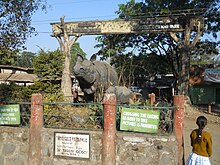The Kaziranga National Park opens to tourists on 1st November, 2015
at 7.00 AM. All tourists are welcome.
Kaziranga National Park – a world heritage site, the park hosts
two-thirds of the world’s Great One-horned rhinoceros. Kaziranga also
boasts the highest density of tigers among the protected areas in the
world and was declared a Tiger Reserve in 2006. Though sighting of
tigers are difficult because of the tall grasses that provide excellent
camouflage, their presence can be felt everywhere by way of pug marks,
kills and territorial markings. The park is home to large breeding
populations of elephants, wild water buffalo and swamp deer.
 Kaziranga National Park and its Addition Areas
Kaziranga National Park and its Addition Areas
Climate : The park experiences three seasons: summer, monsoon, and winter. The
winter season, between November and February, is mild and dry, with a
mean high of 25 °C (77 °F) and low of 5 °C (41 °F). During this season, beels and nallahs (water channels) dry up. The summer season between March and May is hot, with temperatures reaching a high of 37 °C (99 °F). During this season, animals usually are found near water bodies.The rainy monsoon season lasts from June to September, and is
responsible for most of Kaziranga's annual rainfall of 2,220 mm (87 in). During the peak months of July and August, three-fourths of the western
region of the park is submerged, due to the rising water level of the
Brahmaputra.





Grasslands and deciduous forests of Kaziranga

A board proclaiming the biological heritage of the park

Census figures for elephant and rhinoceros in Kaziranga

Entrance gate of Kaziranga National Park

Bonoshree Tourist Lodge in Kaziranga, maintained by the Government of Assam
 Xorai welcome to Kaziranga on NH 37
Xorai welcome to Kaziranga on NH 37
 Kaziranga National Park and its Addition Areas
Kaziranga National Park and its Addition Areas









